Share this!
Look Inside an Ethiopian Coffee Ceremony
How much do you know about Ethiopia? First off, the country sits at the Horn of Africa and is also the biggest landlocked country in the world. With over 100 million inhabitants, Ethiopia is the second-most populous nation on the African continent.
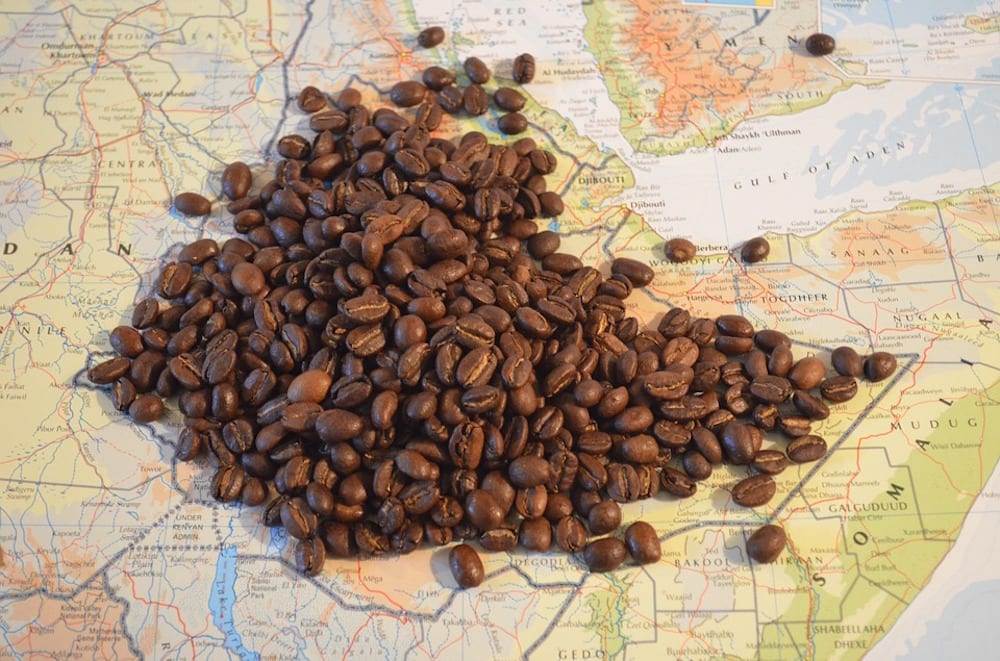
Nothing epitomizes the spirit and culture of Ethiopia than the simple act of drinking coffee. Its tagged the Ethiopian Coffee Ceremony. Take it that you have not experienced life in the country if you have not attended one. It is that consequential.
History
The history of the coffee ceremony makes for an interesting read. Passed down through generations, the story begins from the 10th Century with Ethiopian nomadic goat herders. These herders often took their goats through the Ethiopian highlands. These highlands are a mix of mountains and vast stretches of forests. It is in these forests that our tale begins.
The story centers on a particular herder, Haldi. He noticed that his goats remained active at night after rummaging through the forest greens during the day. He traced the food source to berries from a particular tree. Some theories evolve at this point. One version states that Haldi reported his findings to the head of a local monastery, who in turn consumed the berries and found that it invigorated him at evening prayers. Another theory posits Haldi threw the offending/evil coffee beans into the fire. But the resulting sweet smelling aroma changed his heart. He scooped the burnt seeds from the fire and made himself a drink of coffee.
Whether you are a fan of myths and legends or not, one thing remains certain. The Ethiopian Coffee Ceremony offers energy, sweet aromas and an atmosphere of conviviality.
Cultural Significance
In Ethiopia, the coffee ceremony is the principal way to welcome guests and visitors. In another breadth, it is also a daily activity for friends, neighbors and family members. They gather to celebrate their relationships and offer hospitality to each other. In other words, the coffee ceremony embodies the cultural and social ways of life of the people.
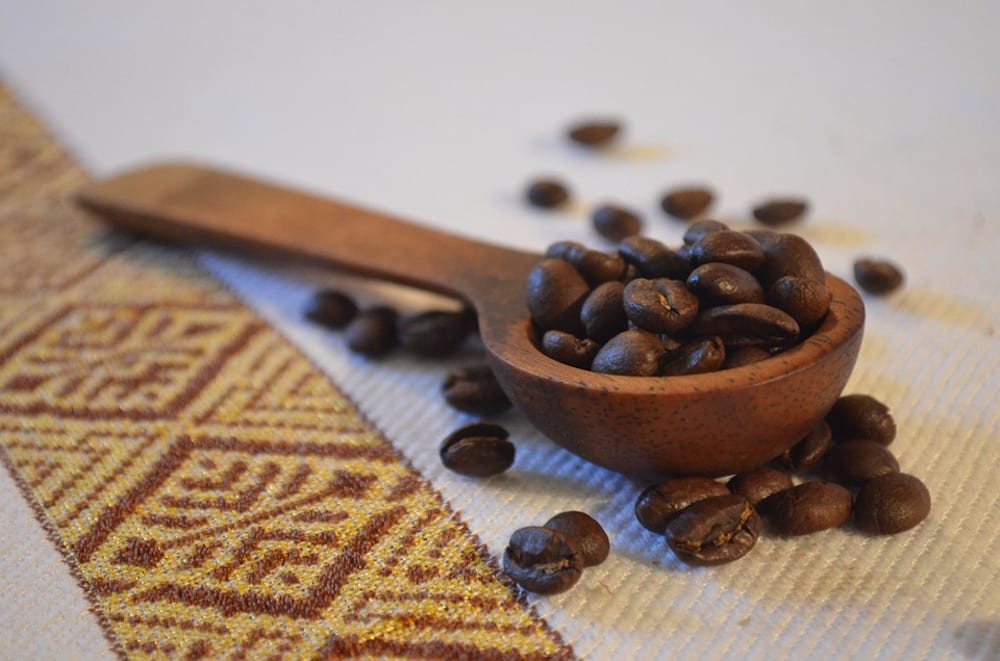
Many Ethiopians also regard the Coffee ceremony as a spiritual journey. This belief builds on the relationship between Islam and coffee. If you partake in one, expect a transformation of your spirit through the three stages of the drinking process.
If you need further convincing, then consider that the ceremony gives rise to Ethiopian Coffee expressions. These expressions delve into the workings of everyday life, food, and human relationships. They are also given in the local parlance, enjoying rich interpretation in the English language. For example, you could hear the words “Buna dabo naw,” which translates to “Coffee is our bread.” This signifies that many Ethiopians associate coffee with life and sustenance.
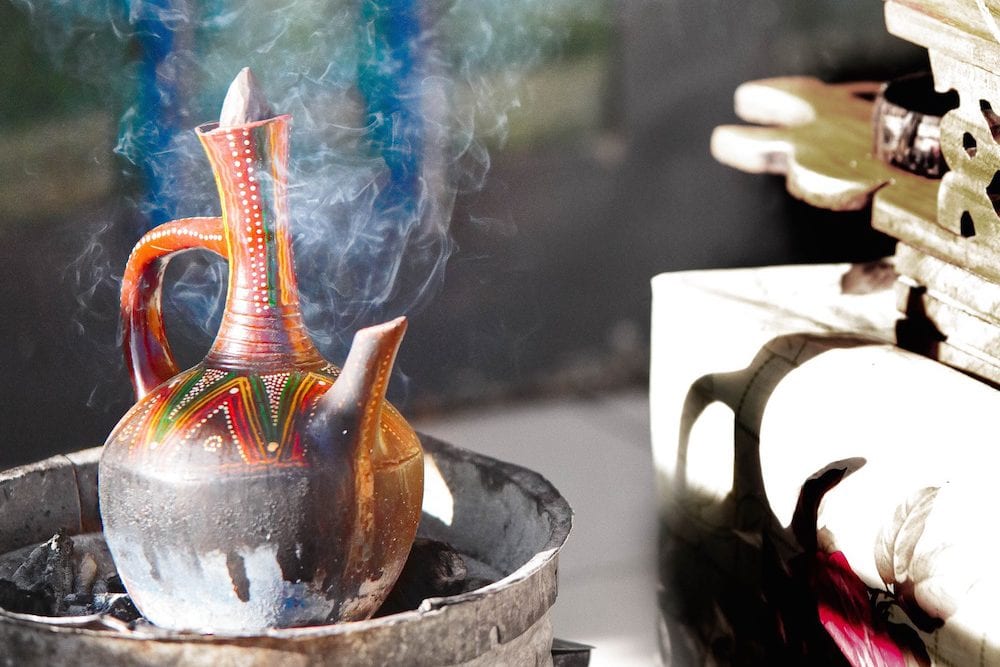
Another popular saying is “Buna Tetu”. A phrase in local Amharic, it means to drink coffee. You should interpret this as going on an immersive journey through the spiritual stages of the coffee ceremony.
And in case a local retorts “Don’t let your name get noticed at coffee time,” don’t scratch your head in confusion. It means you should guard your reputation at all cost, and avoid becoming the subject of negative gossip.
Process and Ceremony
At this juncture, it is fair to post a friendly “warning.” Attending an Ethiopian Coffee Ceremony entails forgetting about time and its demands. Also, you should go through the process with all your senses if you want to enjoy the trappings of the event.
In contemporary times, the lady of the house (or a younger woman) officiates at the Ethiopian Coffee Ceremony. This ceremony could take place at least three times in a day (at breakfast, lunch, and dinner). Each session lasts (on average) for two to three hours; the allusion to time not being of any consequence.
The ceremony involves processing the raw, unwashed coffee beans into finished cups of brewed coffee. Before this event, the dining room undergoes some preparatory rites for the ritual.

Now back to the lady in charge of the event. She spreads fresh, aromatic grasses and/or flowers across the floor, as a welcome sign to attendees. She also begins burning incense to drive away evil/unwanted spirits. Note that incense-burning continues for the duration of the ceremony.
Once everyone gathers around a rekbot. This box-like piece of furniture sits on long scented grasses and flowers. The rekbot carries the handle-less but empty cups for serving the coffee in. The hostess appears attired in a traditional white cotton garment with colored woven borders. She takes the coffee beans and roasts them in a flat iron pan over a small charcoal fire.
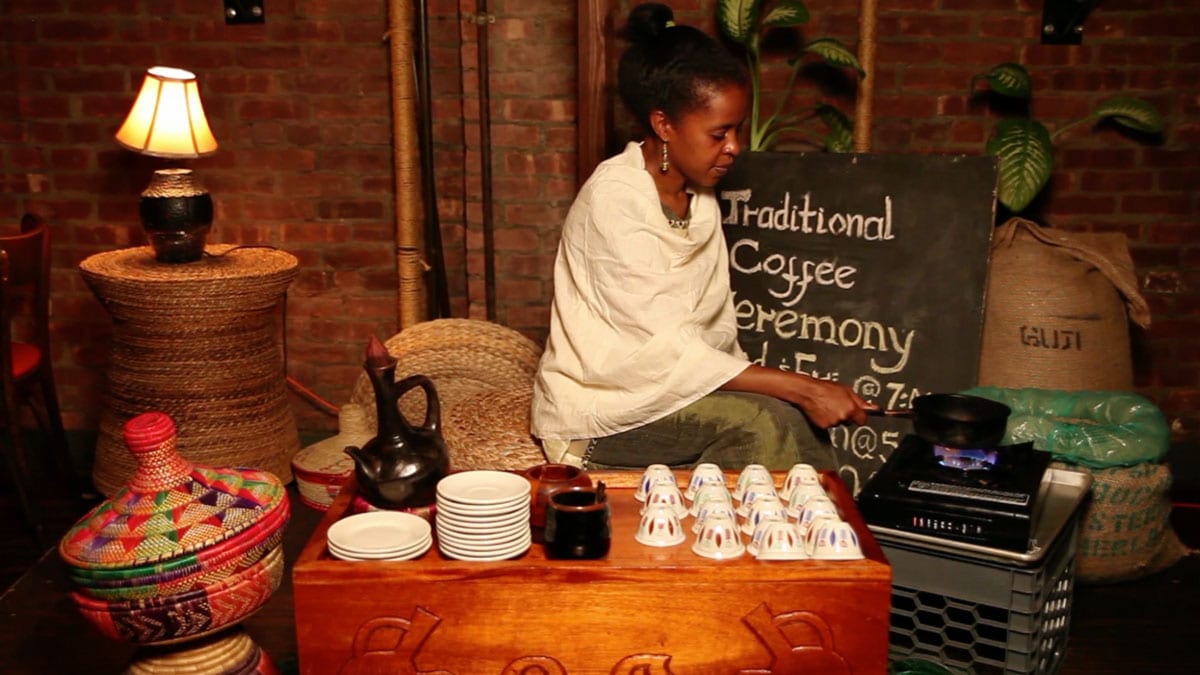
Then your senses come into play. First, you will perceive the delectable, coffee aroma as it permeates the room. As you watch the beans, they turn from their grey-greenish color to a dark, chocolate brown. Your ears take in the rhythmic sounds of the roasting as the hostess swirls the beans in the pan over the fire.
After the beans cool down to room temperature, the next stage involves grinding them on a black stone using a mortar and pestle. The lady places the ground coffee beans in an earthen coffee pot or jebena, filled with boiling water. Expert craftsmanship demands the tilting of the pot at an angle so that the grinds can settle at the bottom while brewing. She adds spices and other additives.
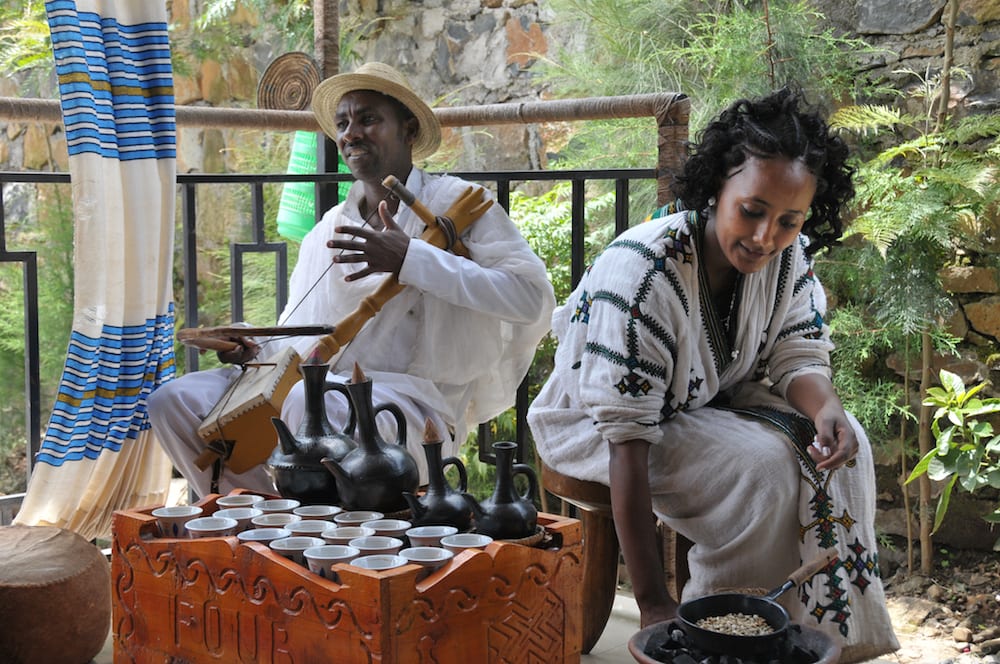
Once steam emanates from the jebena, the coffee is ready. The process of serving coffee is another wonder in itself. The server pours in a single stream from about a foot above the cups, preventing coarse grinds from ending up inside. You can take yours with a varying quantity of sugar (or salt in other cases). Do not expect milk. Enjoy the coffee alongside offerings such as peanuts, a sweet bread, cooked barley or popcorn. The latter snack is a sign of peace and connotes beauty with its close resemblance to a flower.
Coffee Ceremony in Contemporary Times
The Ethiopian Coffee Ceremony has undergone some changes in recent times. These changes include the following:
- Restaurants and many homes use an electric grinder to hasten the grinding process.
- Hostesses may use a fine sieve mesh to filter the grinds.
- Butter and honey add variety to the steaming coffee brew.
Guest Ettiquette
What are your duties as a guest? While a handbook of behavioral patterns does not exist, there are a few rules of engagement at an Ethiopian Coffee Ceremony. The first should be noted even before the ceremony starts. You should not decline an invitation to a coffee ceremony in the first place. Your invitation is a sign of your value as a friend, to partake in the most significant cultural/social happening in Ethiopia.

The next stop is at the ceremony itself. Once the drinking begins, you should contribute to the general discussion and banter expected at the ceremony. The aim of the coffee ceremony in the first place is to create an atmosphere of fun and conviviality. You can discuss a broad range of topics including politics, sports, and family among others.
On a final note, it is impolite to leave the ceremony without consuming at least three cups. You ask why? The reason borders on the third cup conferring the final blessing of the ceremony. Your spirit transforms when you complete the Abol (the first round), Tona (second round), and Baraka (third round). You are free to take as many cups as you wish afterward.
Like this article? Check out more on Ethiopia here!
[amazon_link asins=’B01HFK1M18,B006G7WBZI,B075M4RKVG,B00GHT07B0,B0727WJDB7,B0030IGUI0,B00GHST45Q,B002GWHDJ6′ template=’ProductCarousel’ store=’dawebsite2017-20′ marketplace=’US’ link_id=’611a8f9c-cfff-11e7-8812-5f93700caa46′]







Hi
I just love the country and everything about it. The richness of culture in the way coffee is produced just blows me away. Thank God for Ethiopia.